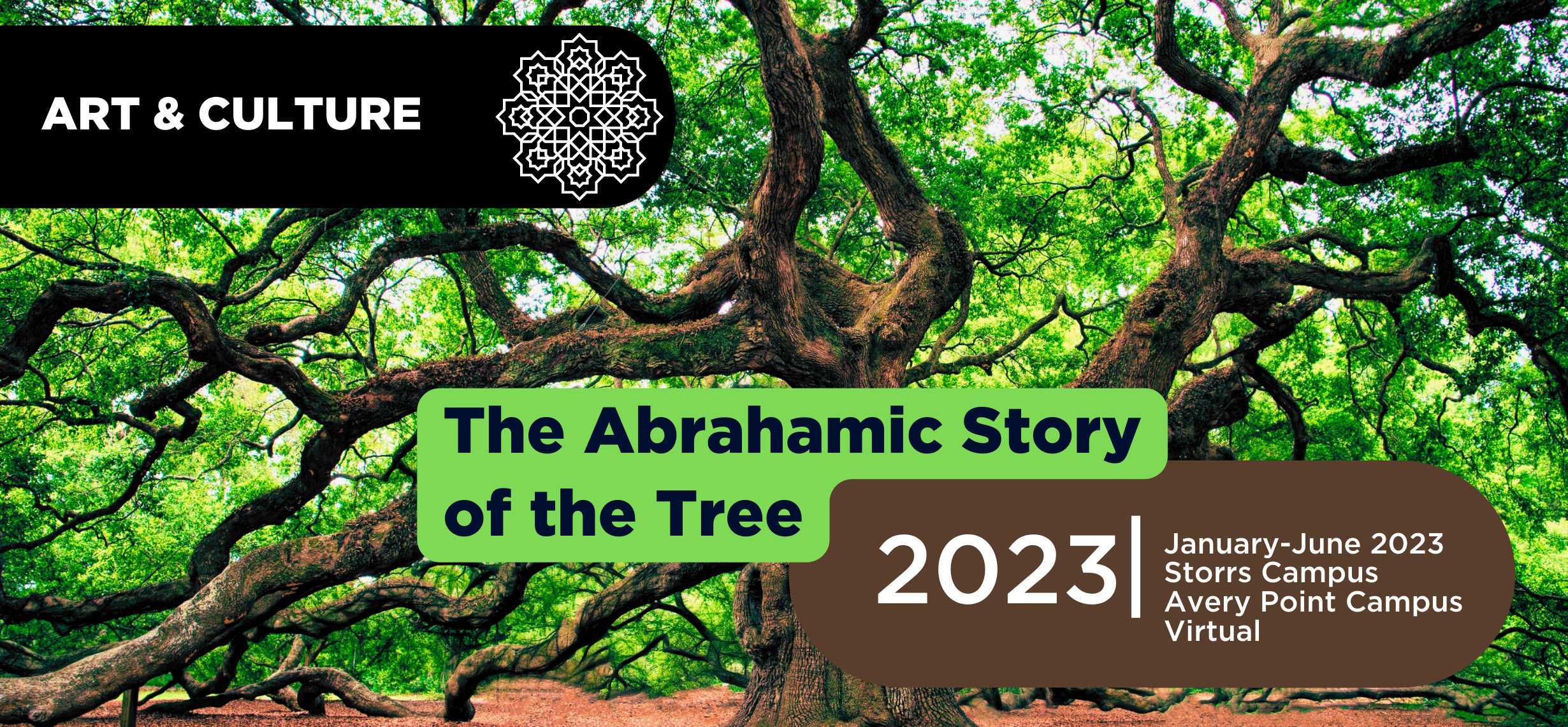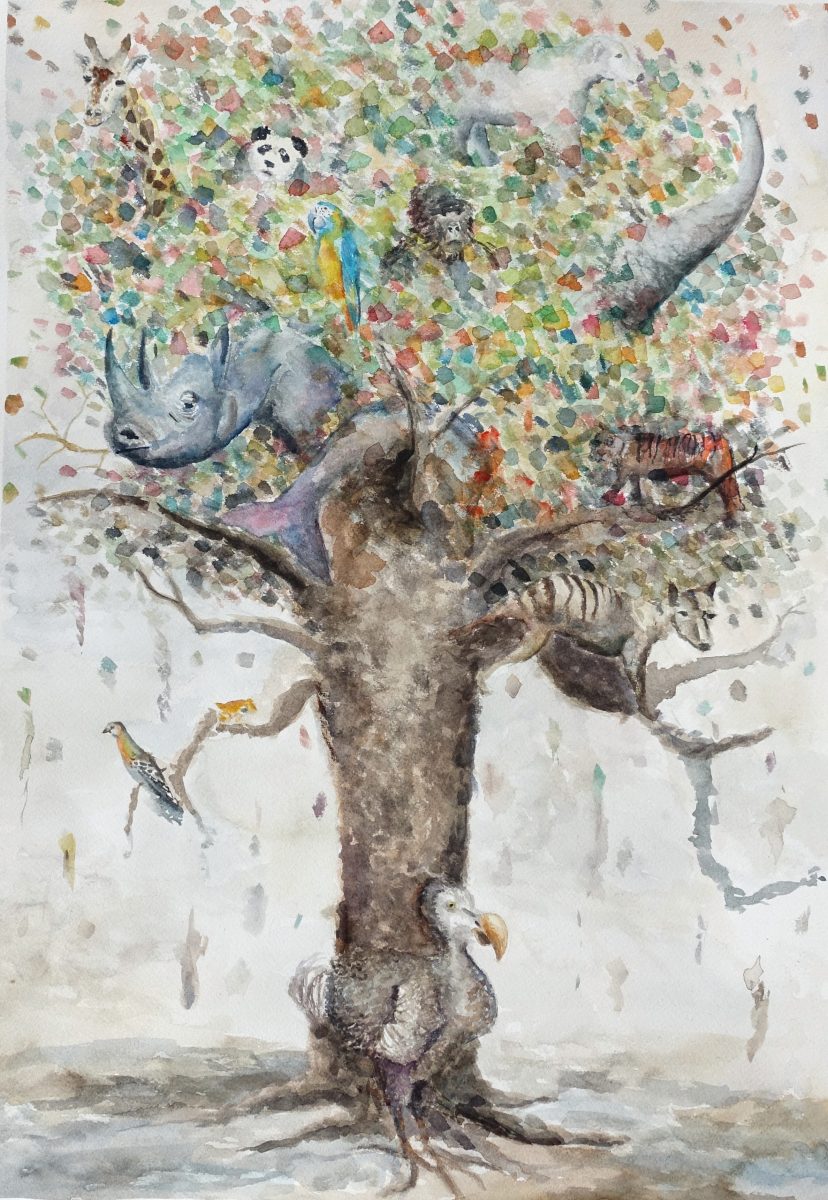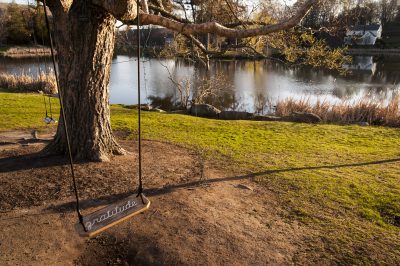
The Abrahamic Story of the Tree
January-June 2023
Connecticut | Open to public
Abrahamic Programs support peaceful co-existence and regional academic integration in the MENA region and provide an alternative framework for productive on-campus programing and dialogue at the University of Connecticut. Along with the School of Fine Arts, Humanities Institute, College of Liberal Arts and Sciences, Human Rights Institute, Asian and Asian American Studies Institute, Ballard Institute and Museum of Puppetry, The William Benton Museum of Art, UConn Hillel, and the Mansfield Downtown Partnership, Abrahamic Programs is proud to present The Story of the Tree.
The Story of the Tree is a semester-long exploration of the Tree of Life in Judaism, Christianity and Islam through art exhibitions, walking tours, performances, and lectures. Read the feature article in UConn Today, and see the full calendar of events below.
Events
Spring 2023
| Date | Event |
| 01.17 - 03.10 | Seeing Truth: Art, Science, Museums, and Making Knowledge UConn Humanities Institute Exhibit William Benton Museum of Art, UConn Storrs |
| 01.26 | 4:00 PM | Seeing Truth: Art, Science, Museums, and Making Knowledge Exhibition Opening William Benton Museum of Art, UConn Storrs |
| 01.30 - 03.10 | Art Students' Exploration - Tree of Life Student Art Exhibit The Dodd Center for Human Rights, UConn Storrs |
| 02.13 | 3:30 PM | Trees in India's Contemporary Indigenous Art Talk by John H. Bowles Arena Gallery, Department of Art and Art History, UConn Storrs |
| 02.17 | 2:00 PM | UConn Botanical Conservatory Tour UConn Botanical Conservatory, UConn Storrs |
| 03.02 | 12:30 PM | The Tree Diagram: Mapping Branches of Knowledge Virtual Talk by Manuel Lima |
| 03.04 | 1:00 PM | UConn Botanical Conservatory Tour UConn Botanical Conservatory, UConn Storrs |
| 03.18 | 2:00 PM | A Nest in the Forest Puppetry Performance led by Neda Izadi, performed by students of Hartford Public Library's After School Academy for English Learners at Center Church, 60 Gold Street, Hartford, CT |
| 03.20 - 05.06 | Art Students' Exploration - Tree of Life Student Art Exhibit Downtown Storrs |
| 03.24 | 2:00 PM | UConn Botanical Conservatory Tour UConn Botanical Conservatory, UConn Storrs |
| 03.30 | 5:30 PM | Deeply Rooted: The Tree of Life Reception and Artist Talk by Beverly Penn Alexey von Schlippe Gallery, UConn Avery Point |
| 03.30 - 04.30 | Deeply Rooted: The Tree of Life Beverly Penn and Katie DeGroot Art Exhibit, with Works by 2025 Master of Fine Arts Candidates Alexey von Schlippe Gallery, UConn Avery Point |
| 03.30 - 06.01 | The Tree in Jewish and Christian Traditions: A Selection of Fine Press Editions, Picture Books and Engravings from Archives & Special Collections, University of Connecticut Library The Dodd Center for Human Rights, UConn Storrs Please call 860.486.2524 for exhibit hours. |
| 03.31 | 2:30 PM | Beverly Penn: Still Nature Artist Talk by Beverly Penn Art Building in front of Contemporary Art Galleries, UConn Storrs |
| 04.01 - 05.07 | Magic and Majesty - The Immortal Tree Art Exhibit William Benton Museum of Art, UConn Storrs |
| 04.12 - 05.04 | Migration of Flora Jumaadi Art Exhibit Contemporary Art Galleries, UConn Storrs |
| 04.12 | 7:00 PM | Jumaadi: From Wayang Kulit to Contemporary Art Puppet Forum with Jumaadi and Matthew Cohen Ballard Institute and Museum of Puppetry, UConn Storrs |
| 04.18 - 04.19 | 7:00 PM | Ramayana: A Tale of Trees and Wood Puppet Performance by Matthew Cohen, Rahul Koonathara and UConn Puppet Arts Ballard Institute and Museum of Puppetry, UConn Storrs |
| 04.20 | Ramayana: A Tale of Trees and Wood Puppet Performance by Matthew Cohen, Rahul Koonathara and UConn Puppet Arts Yale University |
| 04.22 | Ramayana: A Tale of Trees and Wood Puppet Performance by Matthew Cohen, Rahul Koonathara and UConn Puppet Arts Ferguson Library, Stamford |
| 04.26 | Join UConn Hillel to Celebrate Trees Create tree pendent jewelry, build DIY bird feeders, and learn about trees 54 North Eagleville Road, Storrs, CT 06268 |
| 04.27 | 10:00 AM | UConn Arboretum Tour Meet at the Patio between the Benton Museum and the Wilbur Cross Building, UConn Storrs |
| 04.27 - 04.28 | The Tree of Life: Interconnecting Religions, Artistic Traditions, and Scientific Knowledge Conference Humanities Institute, UConn Storrs |
Courses
FALL 2022
Art 3310 Intermediate Painting I (3 Credits)
Instructor: Professor Kathryn Myers
Prerequisite: ART 2310
Conceptually-oriented painting projects.This course will have an assignment related to the Tree of Life/Tree of Knowledge.
Art 3350 Aqua Media I (3 Credits)
Instructor: Professor Kathryn Myers
Prerequisite: ART 1040
Introduction to the materials and methods of painting in aqua media. This course will have an assignment related to the Tree of Life/Tree of Knowledge.
SPRING 2023
ART 5383 Special Topics in Studio Art
Instructor: Professor Kathryn Myers
Seminar focused on special, limited topic relating to practices in studio art. There will be a class project organizing aspects of The Abrahamic Story of the Tree exhibition.
ARTH 2020 Global Jerusalem
Instructor: Professor Kathryn Moore
Trees are essential participants in the web of life. As natural wonders, they have always captivated the human mind and imagination. Their roots extend deep into the soil, and their branches touch the sky. They are a perfect symbol of the connection between earth and heaven, the natural world and the supernatural. They can live for hundreds, even thousands, of years; and they exhibit programmed responses to the perpetual rhythm of the seasons. Clearly their experience of time and longevity is radically different from our own.
The magic and majesty of trees are an integral part of every culture, a foundational element of the human story. In some belief systems trees are considered spirits, even deities, often in feminine form. Through all forms of art, humans have celebrated trees since the dawn of history. Both language and literature use arboreal references to refer to key aspects of our lives: our historical roots and family trees, branches of knowledge and government, the fruits of our labors, and many more.
With the advent of modern science, we now know how our own welfare is interwoven with that of trees. Forests are the lungs of our entire ecosystem. The gaseous exchange trees constantly generate, with the absorption of carbon dioxide and the release of oxygen, is essential for our survival. In this modern age, we have a rational reason to view trees, along with all of nature, with reverence.

"Let my soul, a shining tree,
Silver branches lift towards thee,
Where on a hallowed winter’s night,
The clear-eyed angels may alight."
- Siegfried Sassoon, Poet
(Source: “Tree and Sky”)
"Trees are matter made into memory. Their rings carry the history of their lives in narrow and wide bands of growth, feast and famine mapped into their interior lives, records we are not privy to until the tree falls or is felled. They live lives on a different scale than our own."
- Melina Rudman, Author, Spiritual Director & Gardener (Source: Sacred Soil: A Gardener’s Book of Reflection)
"Trees who unwhispering stand,
Umber and bronze and gold;
Pavilioning the land,
For one grown tired and old;
Elm, chestnut, beech and lime,
I am merged in you, who tell;
Once more in tones of time,
Your foliaged farewell."
- Siegfried Sassoon, Poet (Source: “October Trees”)
"[Trees] are really not individuals in the sense that Darwin thought, competing for survival of the fittest. In fact, they are interacting with each other, trying to help each other survive."
- Suzanne Simard, Forest Ecologist (Source: https://youtu.be/-8SORM4dYG8)

"I was standing on the highest mountain of them all, and round about beneath me was the whole hoop of the world. And while I stood there I saw more than I can tell and I understood more than I saw; for I was seeing in a sacred manner the shapes of all things in the spirit, and the shape of all shapes as they must live together like one being. And I saw that the sacred hoop of my people was one of many hoops that made one circle, wide as daylight and as starlight, and in the center grew one mighty flowering tree to shelter all the children of one mother and one father. And I saw it was holy…but anywhere is the center of the world."
- Black Elk, Oglala Lakota leader (1863-1950), as told to John G. Neihardt
References to Sacred Trees in Judaism, Christianity, and Islam
JUDAISM offers a variety of teachings about trees and their significance, both physically and metaphysically. In the account of Creation in Genesis, which is foundational for both Judaism and Christianity, two archetypal trees in the primordial Garden of Eden are described: a Tree of the Knowledge of Good and Evil and a Tree of Life. In this tree imagery, the Bible’s story of human origins makes the connection between knowledge—the life of the mind, including conscience and imagination—and the essential life force that undergirds our existence and transcends the mortality of the body.
Deuteronomy 20:19 asserts that “the human being is like a tree of the field,” suggesting we share essential qualities with our botanical neighbors. The Book of Proverbs uses the Tree of Life (Eitz Chayyim) metaphor to describe the Torah, the wellspring of Divine teaching. In Kabbalah, the Jewish mystical tradition, the Tree of Life symbolism is used to designate ten Divine emanations (sefirot) that infuse all of Creation. Kabbalistic insights have also inspired a messianic meal, comprising fruits and nuts from the Holy Land, associated with the Jewish festival of Tu B’Shvat, the New Year of the Trees celebrated in late January or early February.
In CHRISTIANITY, the Cross on which Jesus was crucified is sometimes described as a Tree of Life, with its vertical and horizontal axes resembling a tree trunk and branches. Like a tree, the Cross connects heaven and earth as it represents reconciliation between God and humanity. For Christians, the Cross is the material instrument for effecting human atonement and salvation; and, as such, it is also a portal to immortality.
At the end of the New Testament, the Book of Revelation (22:1-2) offers a mystical vision of the new Jerusalem descending from heaven:
Then the angel showed me the river of the water of life, bright as crystal, flowing from the throne of God and of the Lamb through the middle of the street of the city. On either side of the river is the Tree of Life with its twelve kinds of fruit, producing its fruit each month; and the leaves of the Tree are for the healing of the nations.
In ISLAM, there are many references to trees, with two particular trees highlighted. The first is the Tree of Immortality (Shajarat al-Khulud), the only tree associated with the primordial Garden; and the second is Tuba (blessedness), a tree growing in Paradise, a realm also referred to as a Garden/Jannah. The parallels to Christian tradition are evident.
Jews, Christians, and Muslims share common origins in the Middle East, where the olive tree is especially important, valued for both its fruit and its oil. It is a vital element in the economies of the region, with entire families taking part in the annual olive harvest. The olive branch represents peace, shalom, salaam, an elusive and yearned-for blessing in a region weary of armed conflict. Olive oil is associated with light, purification, and anointment. It is a tangible symbol of consecration. The Qur’an, in Surat an-Nur (the Chapter of Light, 24:35), contains this sublime passage:
Allah is the Light of the heavens and the earth. The parable of His Light is as if there were a niche containing a lamp; the lamp enclosed in glass; the glass [shining] like a brilliant star: lit from a blessed tree, an olive tree that is neither of the East nor of the West, whose oil is well-nigh luminous even though fire had not touched it: Light upon Light! Allah guides unto His Light the person who wills [to be guided]; and [to this end] Allah propounds parables to human beings, since Allah alone has full knowledge of all things.
Trees and the Mission of a University

In these scriptural passages from the three Abrahamic traditions, the cosmic web connecting light, life, and knowledge is affirmed. For an academic institution like the University of Connecticut, these interconnections constitute its primary task and aspiration: to make the pursuit and transmission of knowledge a force that enlightens human minds and enhances life. Transcending geography and culture, a university is a learning community that cultivates fruitful connections: between the sciences and the humanities, between the past and the present, and between the mind and the spirit. By bringing people together from different cultural backgrounds and academic disciplines, a university serves as the cutting edge of society, planting seeds of wisdom and cultivating those seeds until they germinate, grow, branch out, and bear fruit.
For this transcendent pursuit of truth and wisdom, the tree is an

illuminating symbol of our highest potential. Like humans, trees are interdependent social beings, communicating with each other through underground fungal networks. They are mutually supportive, with the stronger, more mature trees sharing nutrients with the weaker, more vulnerable trees around them. And a forest thrives best when it is comprised of a variety of tree species, since diversity serves collective survival and enrichment. Trees, through their living example, demonstrate how cooperation across lines of difference, rather than ego-driven competition, benefits every member of the community.
Trees have much to teach us, if we can open our minds and our hearts to integrate their wisdom in our own lives.
WORKING GROUP
Zahra Ali, Ph.D. Student, Plant Science and Landscape Architecture, UConn
Elizabeth Athens, Associate Professor of Art History, UConn
Alexis Boylan, Associate Professor of Art History & Africana Studies; Director of Academic Affairs, Humanities Institute, UConn
Jeanne Ciravolo, Director of the Alexey von Schlippe Gallery of Art Gallery, Avery Point Campus and Assistant Professor in Residence of Art & Art History, UConn
Neda Izadi, Coordinator, Middle East Cultural Programs, UConn
Cynthia Jones, Professor of Ecology & Evolutionary Biology; Director, Plant Biodiversity Conservatory Greenhouses, UConn
Kinga H. Karlowska, Global Initiatives Coordinator, UConn
Yehezkel Landau, Consultant, Landau Interfaith
Macushla Robinson, Director of the Contemporary Art Gallery and Assistant Professor in Residence of Art & Art History, UConn
Kathryn Moore, Assistant Professor of Art History, UConn
Kathryn Myers, Professor of Painting, UConn
Jeremy Pressman, Professor of Political Science & Director of Middle East Studies, UConn
Judith Thorpe, Professor and MFA Program Director & Professor of Photography, UConn
Daniel Weiner, Vice President for Global Affairs and Professor of Geography, UConn